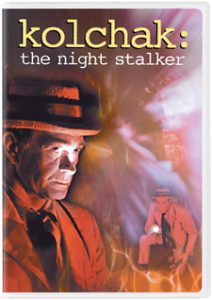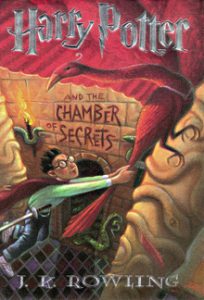For the 20th anniversary of “Harry Potter,” I’m looking back at the books and films of J.K. Rowling’s Wizarding World saga.
“Harry Potter and the Chamber of Secrets” (1998) is the first book where J.K. Rowling was writing for an expectant audience. “Sorcerer’s Stone” went seven years from gestation to published product, but for the sequel, Rowling wrote to an established fanbase. (Still, “Harry Potter” wasn’t at its peak of popularity yet, as again there was a one-year gap between the U.K. and U.S. releases.)
Rowling writes with confidence rather than nerves, perhaps thanks to her meticulous note-taking about the Wizarding World. She plays it safe, as “Chamber of Secrets” has the same plot structure as the first book: Rather than figuring out who is after the Sorcerer’s Stone (and where it’s located), Harry, Ron and Hermione must discover who has opened the Chamber of Secrets (and where it’s located). And again, it’s written in an appealing slow-burn style, where each chapter is a short story that slightly advances the main plot, and the titular device isn’t revealed until well after page 100.
The use of the same structure is not a criticism, because I find it as comforting as the plush chairs in the Gryffindor common room, just as the author – who admitted to feeling pressure while writing the book — perhaps saw it as being in her comfort zone. Aside from quick reminders about who’s who and what’s what, “Chamber” doesn’t repeat itself, and Rowling’s imagination is such that we don’t feel she’s straining to avoid repetition. Rather, we are always learning something new about the world of magic.
Instead of taking the Hogwarts Express to school, Harry and Ron take Mr. Weasley’s enchanted Ford Anglia. Instead of meeting centaurs in the Forbidden Forest, our heroes meet giant spiders. Instead of a secret chamber in a third-floor hallway, this one is in Moaning Myrtle’s bathroom, and it leads below the lake.
“Chamber” is a darker book, with the initial salvo coming in Chapter 8, “The Deathday Party.” To be nice, Harry, Ron and Hermione attend Nearly Headless Nick’s 500th deathday party in a freezing dungeon room, with a buffet of spoiled food, and with ghosts playing hockey with their dismembered heads. Harry sees a ghost walk through a plate of stinking salmon and asks if he can taste it that way. Rowling writes:
“Almost,” said the ghost sadly, and he drifted away.
That’s a rather melancholy moment for a book aimed at 12-year-olds. A more prominent comic-relief ghost is Moaning Myrtle, who haunts an out-of-order girls’ bathroom where Harry, Ron and Hermione do a lot of their pontificating about the mystery. I picture something like those forgotten underground rooms from the “Saw” movies; there’s something about an abandoned bathroom in an ancient building that is particularly skin-crawling.
The height of the dark drama occurs when Aragog, leader of the giant spiders in the Forbidden Forest, intends to murder Harry and Ron and serve them for dinner in Chapter 15. In a more understated bit of black humor, the Mandrakes are described like screaming Cabbage Patch Kids (and Mary GrandPre’s illustration emphasizes this), yet we’re told Madam Pomfrey will be cutting them up to make a cure for the Petrified students. All of this illustrates how Rowling (correctly) believes kids can handle more than we give them credit for; no doubt adults like me are more disturbed than the young readers.

That’s not to say Rowling’s trademark playful humor is absent. In addition to peppering little smile-worthy moments throughout (Snape sneezes at the same moment Ron stubs his toe, allowing Ron and Harry to sneak past), Rowling seems to have an eye on the future big-screen adaptation of “Chamber” with the Polyjuice Potion sequence, where Harry and Ron take up the guises of Crabbe and Goyle to try to get information out of Malfoy. Did Rowling know her books would be made into films at this point? Probably. But the sequence is funny in book form, too, along with the kicker where Hermione accidentally transforms herself into a humanoid cat, forcing her to stay in the hospital wing throughout January.
“Chamber’s” broadest comedy comes courtesy of boastful phony Gilderoy Lockhart, the latest Defense Against the Dark Arts teacher. He is a joke pounded into the ground, never revealing hidden depths — which is the point, but still. A new character who will stick around for future books is Dobby the self-flaggelating house-elf; he’s also a bit annoying at this point. In both cases, the characters are just as annoyed as readers are, so it’s not a huge problem.
“Sorcerer’s Stone’s” mystery was pretty good for a YA novel, as a savvy reader might’ve figured out that when Hermione supposedly rescued Harry from Snape’s spell at the Quidditch match, she actually rescued him from Quirrell. Most of the Book 1 clues come from Hagrid spilling the beans — which is amusing, but readers aren’t asked to do much legwork.
“Chamber” really shines with its mystery, which also gives us insight into Hogwarts’ checkered history. The fact that “Tom Morvolo Riddle” can be rearranged into “Lord Voldemort” is just plain fun, and I have no doubt that many kids delightedly figured this out on their first read. The reveal that Ginny’s behavior is not out of fear of the Heir of Slytherin, but out of fear that she’s being controlled by the Heir, is suitably creepy.
Again, Harry doesn’t precisely face Voldemort one-on-one. I like the way Rowling is building up to that, giving Harry a bit more of a test in each book. Here, he faces a 1942-vintage Tom Riddle, whom Ginny had inadvertently freed from his diary by pouring out her misery, which Riddle uses to build his strength. And Harry needs the help of Dumbledore’s pet phoenix, Fawkes, to win the day.
But that’s not really the point. The kids’ growth is not measured by their victory tally – although, yes, Gryffindor wins the House Cup again – but rather in their bravery, as inspired by each other. After Hermione is Petrified, the latest victim of the Chamber’s mysterious monster (eventually revealed to be a basilisk), Harry suggests to Ron that they follow the spiders into the forest, as per Hagrid’s clue. Rowling writes:
(Ron) looked sideways at the empty seat usually filled by Hermione. The sight seemed to stiffen his resolve, and he nodded.
In retrospect, Rowling is already planting seeds for getting Ron and Hermione together – as well as Ginny and Harry – but I like how it’s subtle.
Probably the biggest unexplained element of “Chamber” is the ages of the adult characters. We learn that Hagrid is 63 (in the flashbacks to 50 years ago, he is 13), and that if Dumbledore was already a professor a half-century ago, he’s probably about 90 in this book. (Voldemort is 66 at this point, but because he is steeped in the Dark Arts, that’s not a narrative problem.) Up to this point, it seemed to me that Hagrid was maybe 40 and Dumbledore was maybe 70, and indeed, the movies would later cast actors who reflected that.
I don’t know if Rowling explains the surprising ages of these characters in her Pottermore website writings (I’m pretty sure she doesn’t in the books), but a likely theory is that people with magic abilities age more slowly because their daily lives are easier than those of Muggles. A similar phenomenon is found in the “Star Wars” Expanded Universe novels, where Luke, Han and Leia are still moving around like 40-year-olds when they are in their 70s. In the real world, we have longer life expectancies than our ancestors because of advances in science, technology and the overall quality of living.
The revelation that Riddle opened the Chamber of Secrets 50 years ago gives the “Potter” saga more of an epic scope, as we realize Voldemort has been terrorizing the Wizarding World for three generations now, not just two, as we might’ve assumed.
Interestingly, “Chamber of Secrets” is a popular choice for the weakest book of the series, with the borrowed plot structure and the annoying Lockhart often cited. But even many people who rank it there admit it’s still pretty good. I guess I have some great stuff ahead of me on this re-read.
Movie review: “Chamber of Secrets”
Next book: “Prisoner of Azkaban”

